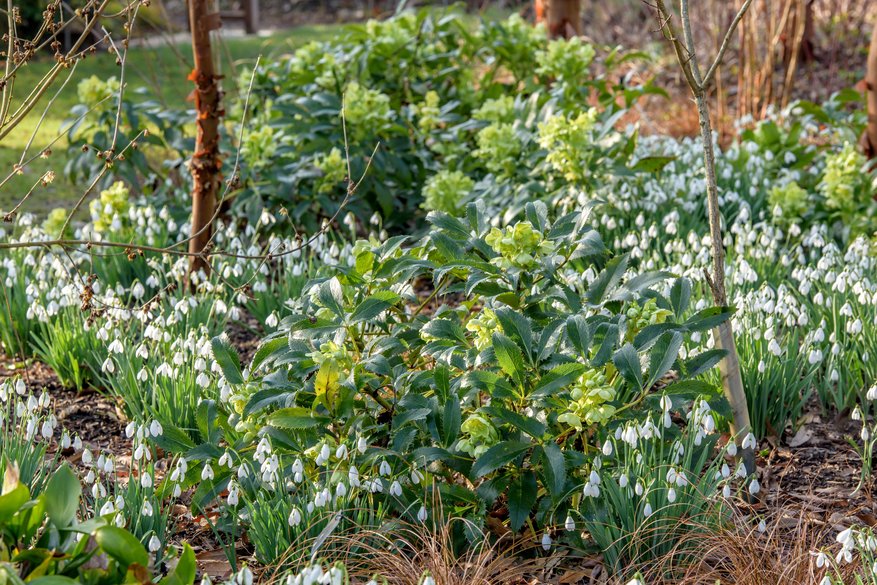Helleborus argitifolius
£12.50
Description
Quick Facts
- Common Name: Corsican Hellebore, Holly-leaved Hellebore
- Botanical Name: Helleborus argutifolius
- Plant Type: Evergreen perennial
- Mature Height: 60-120cm
- Mature Spread: 60-90cm
- Flowering Period: January to April
- Flower Colour: Pale apple-green
- Foliage: Bold, spiny-edged, trifoliate leaves in rich green
- Hardiness: RHS H5 (fully hardy)
- Soil Requirements: Well-drained, neutral to alkaline
- Aspect: Partial shade to full sun
- Maintenance: Low
Description
Discover the bold architectural beauty of Helleborus argutifolius, the magnificent Corsican Hellebore that brings dramatic structure and ethereal green blooms to English gardens throughout the darkest months. This statuesque perennial stands apart from its hellebore cousins with its commanding presence and striking foliage, creating a sculptural focal point that captivates attention in every season whilst offering months of exquisite winter and spring flowers.
From midwinter through mid-spring, this impressive plant produces abundant clusters of large, cup-shaped flowers in the most enchanting shade of pale apple-green, each bloom held proudly upright rather than nodding. The substantial flower heads create clouds of lime-green that seem to glow against winter’s muted palette. The bold, holly-like foliage—composed of three spiny-edged leaflets arranged in striking architectural tiers—provides year-round drama and structure that few perennials can match.
Named for its native home in Corsica and Sardinia, this Mediterranean treasure brings remarkable adaptability to English conditions. More tolerant of sun and drier conditions than other hellebores, ‘argutifolius’ thrives in our climate whilst offering exceptional longevity and presence. The statuesque habit and distinctive serrated foliage create instant impact, making this a true statement plant for contemporary and traditional gardens alike.
Create stunning architectural compositions by pairing this bold beauty with ornamental grasses, euphorbias, and bronze fennel for textural contrast, or combine with early spring bulbs and evergreen ferns for layered seasonal interest. Magnificent as a specimen plant in gravel gardens, in mixed borders where its height adds vertical drama, or massed for powerful impact where its sculptural presence and luminous flowers will bring sophistication and year-round beauty to your Irish garden sanctuary.
Caragh Garden Notebook
Planting: Space plants 60-90cm apart in well-drained soil. Plant in autumn or early spring in a position with good drainage. Dig holes twice the width of the root ball and incorporate grit and organic matter. Plant with the crown at soil level. Water thoroughly after planting. Mulch lightly, keeping mulch away from the crown.
Soil Preparation: Thrives in neutral to alkaline soil with pH 7.0-8.5, though tolerates slightly acidic conditions. Requires excellent drainage—avoid heavy, waterlogged soils. In clay soils, incorporate generous amounts of horticultural grit and organic matter, or plant in raised beds. More drought-tolerant than other hellebores once established.
Container Growing: Excellent for large containers using quality, soil-based compost with added grit for drainage. Choose pots minimum 40cm diameter and depth to accommodate the substantial root system. Water regularly during growing season but allow to dry slightly between waterings. Feed monthly during growing season with balanced liquid fertiliser. Protect from excessive winter wet.
Seasonal Care: Remove old flowering stems after blooms fade in late spring to maintain appearance and encourage fresh foliage growth. Cut back any damaged or tatty leaves as needed. Apply slow-release balanced fertiliser in early spring. Mulch lightly with grit or gravel rather than organic matter. Water during prolonged dry spells when establishing. Generally pest and disease-free.
Propagation: Collect and sow fresh seed in summer—seedlings will appear the following spring and flower in 2-3 years. Self-seeds moderately in favourable conditions. Can be divided in early autumn, though plants dislike disturbance and division is rarely necessary. Best propagated from seed for vigorous, long-lived plants.





